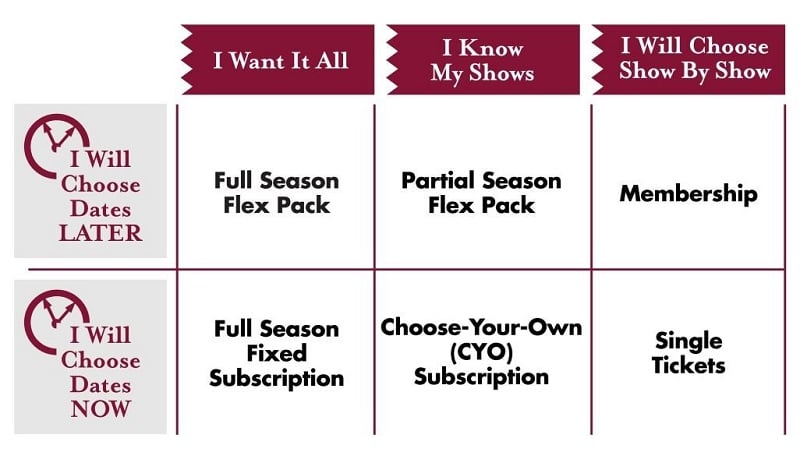3 min read
Customer-Centric Marketing: Flexible ticket models

Performing arts organizations are reporting a decline in subscriptions numbers and revenues, ever since the pandemic transformed the arts marketing world.
Rani Haywood, Senior Vice President of Tom O’Connor Consulting Group, shared the data with us - and told us why this has been a much-discussed topic in their monthly Performing Arts Marketing Roundtables. In this blog she offers advice on how performing arts organizations can respond and experiment with new event ticketing and marketing models.
We work with Tom O'Connor Consulting Group and other experts to support best practices in arts and theater marketing.
Experimenting with new arts marketing models
The 2022-23 season in North America – and the 2023 season in Australia – saw some uptick in both renewing and new subscribers, but the trends seem to indicate that the numbers may not return to pre-pandemic levels.
At Tom O’Connor Consulting Group (TOCG) we’ve been advising clients on how to respond to the trends, and have been recommending experimenting with new models and incentives including:
- Extending the definition of a lapsed subscriber,and allowing people to renew into their pre-pandemic seats or packages even three seasons on.
- Reducing the number of performances required to make up a subscription or package.
- Adding more flexible packages alongside traditional fixed packages, or phasing out fixed seat subscriptions entirely where acquisition is concerned.
- Introducing other models such as membership either to replace or complement subscriptions.
- Shifting marketing budget and effort to single ticket marketing.
The last point is particularly interesting to TOCG, as we work with many of our clients on team structure and resourcing. The revenue balance is shifting from subscriptions to single ticket purchases, and we’ve found ourselves having conversations about the team and the budget needed to drive more robust single-ticket campaigns.
A customer-centric approach to marketing and ticketing
It used to be that the majority of performing arts companies offered two options for ticket buyers: pre-determined subscription packages bought well in advance or single tickets bought closer to performances. As customer behavior changed, companies started to respond with more options such as mini packages, flex passes and single ticket bundles. Mostly, these grew around the offerings already available and processes that worked for the company rather than being customer-centric.
Increasingly we believe that arts marketing teams need to take stock and consider all the ways in which our customers want to engage with their organisation and shape multiple ticket offerings around customer needs.
One model that we’ve used with clients follows two dimensions: the level to which customers know what they want to buy and the point at which they want to commit. Below is an example of how a US performing arts company might construct its ticket offerings using this model:

This model is a fairly simple way for arts marketers to map out what their organization is currently offering and where the gaps are. We truly believe that an organization could – and should – be offering all these options at the same time!
Different audiences want to engage differently – and if an audience member doesn’t see an offering that suits their needs and preferences they will be more likely to spend less, rather than opting to spend more.
What do audiences want when they buy tickets?
As performing arts companies start planning for their upcoming seasons, we encourage our marketing colleagues to ask these questions of their organization:
- Are you offering customer-friendly ticketing options that live somewhere between subscriptions and single tickets? Or are you asking them to pick solely between these two extremes?
- Have you asked your audiences how and when they want to commit to buying tickets?
- How does your organization acknowledge and reward loyalty?
- Do you have the appropriate marketing team and budget to support the shift towards smaller package or single ticket marketing?
- Have you, or do you need to, restructure your marketing budget to support multiple ticket offerings?
In summary, we want to win our customers back for our current and upcoming seasons, but we shouldn’t assume that they will engage with us in the same way that they did in the past. We need to push ourselves and our organisations to question what we are offering, meet our audiences where they are, and create a more customer-centric marketing approach to thrive in the contemporary world.
This content was first presented in February 2023 as part of The Future of Patron Loyalty, a panel event hosted by Spektrix. View the full recording and slides below.
Rani Haywood is Senior Vice President of Tom O’Connor Consulting Group. TOCG is a NYC-based consultancy for arts and cultural institutions and leaders, offering two complementary services: organizational strategy and executive search. For over fifteen years Rani has held senior marketing roles at an array of performing arts and cultural organizations in Australia and the United States, including at The Metropolitan Opera, Roundabout Theatre Company and Sydney Theatre Company.
Join TOCG's Performing Arts Marketing Roundtables.



